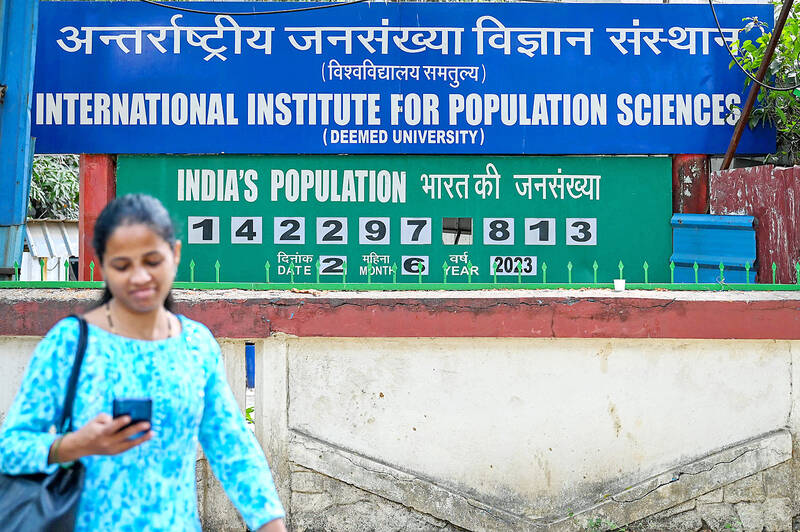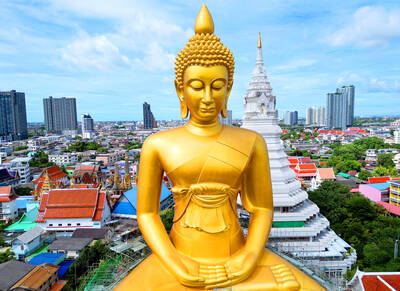India’s first population clock, made up of 10 white numbered cards on a large green metal board, attracts curious passersby who watch it record the story of the world’s most populous nation.
The clock — manually updated every day according to projected estimates, and akin to a cricket scoreboard in appearance — was erected in 1982 when India was home to more than 684 million people, according to the 1981 government census.
That figure more than doubled in the following decades. India grew rapidly to overtake China at the top of the population ranks with more than 1.42 billion people, the UN said in April.

Photo: AFP
“An extra slot had already been made in the clock, expecting that we were going to cross 1 billion,” International Institute for Population Sciences professor Chander Shekhar said in Mumbai, where the clock is.
Overpopulation has long been a concern, with the government establishing a nationwide family planning program in 1952.
However, it was a controversial enforced-sterilization push in the 1970s that sparked public debates and spurred the institute to create the clock, Shekhar said.
Every day, security guards change the numbers using projections of the natural growth rate — the difference between the number of births and the number of deaths per 1,000 a year — derived from government and UN estimates.
“We feel good when we update the board, as passersby can also see the growing population numbers,” 56-year-old security supervisor Salunkhe V.V. said.
The projections estimate that India’s population increases by just under 41,000 people per day — one every two seconds — or about 15 million per year.
India’s fertility rate is two births per woman, just under the replacement threshold of 2.1, and down from government estimates of 4.8 in 1981.
The fertility rate varies across the country, with poorer states such as Uttar Pradesh and Bihar — boasting a combined population of more than 325 million — having the highest rates, a 2019 government survey showed.
In contrast, the two wealthiest states of Maharashtra and Tamil Nadu have fertility rates of 1.56 and 1.54 respectively, far below the average, the survey showed.
Family planning has largely been left to women, with less than one in 10 men using condoms, while female sterilization was at nearly 38 percent, India’s 2019 to 2021 family health survey showed.
Shekhar, 49, was drawn to studying population from a young age, fascinated and “agitated” by large crowds of people everywhere he went.
“I used to hate these numbers,” Shekhar said. “But after I got my master’s in statistics, I thought, ‘Let us understand this, is it a problem? Or can it really be solved?’”
Shekhar said the large numbers do not have to be a ticking time bomb if authorities focus on raising people’s quality of life.
Education and health outcomes — such as falling infant and maternal mortality rates — have improved since 1982, and India’s economy has grown to the fifth-largest in the world.
However, in many cities, residents battle for resources while facing water shortages and air and water pollution.
Youth unemployment for the ages of 15 to 24 stood at 23.2 percent last year, the World Bank said.
The overall jobless rate was 7.7 percent in May, Centre for Monitoring Indian Economy data showed.
Shekhar said a key concern was that “India will become older before it becomes richer.”
“For that [not to happen], we need to have people be skilled, and have employment opportunities for a huge, young, bulge of population,” he said.

IDENTITY: A sex extortion scandal involving Thai monks has deeply shaken public trust in the clergy, with 11 monks implicated in financial misconduct Reverence for the saffron-robed Buddhist monkhood is deeply woven into Thai society, but a sex extortion scandal has besmirched the clergy and left the devout questioning their faith. Thai police this week arrested a woman accused of bedding at least 11 monks in breach of their vows of celibacy, before blackmailing them with thousands of secretly taken photos of their trysts. The monks are said to have paid nearly US$12 million, funneled out of their monasteries, funded by donations from laypeople hoping to increase their merit and prospects for reincarnation. The scandal provoked outrage over hypocrisy in the monkhood, concern that their status

The United States Federal Communications Commission said on Wednesday it plans to adopt rules to bar companies from connecting undersea submarine communication cables to the US that include Chinese technology or equipment. “We have seen submarine cable infrastructure threatened in recent years by foreign adversaries, like China,” FCC Chair Brendan Carr said in a statement. “We are therefore taking action here to guard our submarine cables against foreign adversary ownership, and access as well as cyber and physical threats.” The United States has for years expressed concerns about China’s role in handling network traffic and the potential for espionage. The U.S. has

A disillusioned Japanese electorate feeling the economic pinch goes to the polls today, as a right-wing party promoting a “Japanese first” agenda gains popularity, with fears over foreigners becoming a major election issue. Birthed on YouTube during the COVID-19 pandemic, spreading conspiracy theories about vaccinations and a cabal of global elites, the Sanseito Party has widened its appeal ahead of today’s upper house vote — railing against immigration and dragging rhetoric that was once confined to Japan’s political fringes into the mainstream. Polls show the party might only secure 10 to 15 of the 125 seats up for grabs, but it is

The US Department of Education on Tuesday said it opened a foreign funding investigation into the University of Michigan (UM) while alleging it found “inaccurate and incomplete disclosures” in a review of the university’s foreign reports, after two Chinese scientists linked to the school were separately charged with smuggling biological materials into the US. As part of the investigation, the department asked the university to share, within 30 days, tax records related to foreign funding, a list of foreign gifts, grants and contracts with any foreign source, and other documents, the department said in a statement and in a letter to